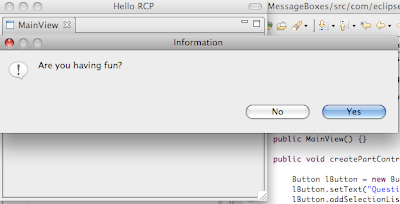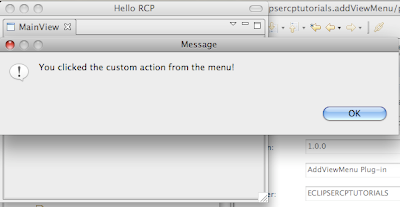A friend recently sent me this link about the future of transistors and some ideas of how to reduce chip power consumption once transistors can't be made any smaller. A good one-hour (pre)review of electrical engineering...
Tuesday, June 29, 2010
Sunday, June 27, 2010
Monday, June 21, 2010
Using Simple JFace Message Boxes in an Eclipse RCP Application
 This article shows how to use JFace messages boxes in an RCP application and builds off of a clean RCP Application with a View. The full source code is found at the end of the article. Most if not all GUI applications frequently use message boxes to give or get information to or from the user. Jface provides us with 5 commonly used message boxes which can be conveniently used via a single static method. The available message boxes are:
This article shows how to use JFace messages boxes in an RCP application and builds off of a clean RCP Application with a View. The full source code is found at the end of the article. Most if not all GUI applications frequently use message boxes to give or get information to or from the user. Jface provides us with 5 commonly used message boxes which can be conveniently used via a single static method. The available message boxes are:- MessageDialog.openQuestion()
- MessageDialog.openInformation()
- MessageDialog.openWarning()
- MessageDialog.openConfirm()
- MessageDialog.openError()
To demonstrate the JFace Message Boxes used in an Eclipse RCP application, a view containing a single button is created. When the button is clicked, a Question message box pops up, and depending on the boolean value returned, opens up either a Warning or an Information message box.
Step 0: Create an Eclipse RCP Application with a View.
Step 1: Add code to the createPartControl() method in the application's view to add a button and set its action listener, coding the calls to the JFace message box static methods.
package com.eclipsercptutorials.jfacemessageboxes;
import org.eclipse.jface.dialogs.MessageDialog;
import org.eclipse.swt.SWT;
import org.eclipse.swt.events.SelectionAdapter;
import org.eclipse.swt.events.SelectionEvent;
import org.eclipse.swt.layout.RowLayout;
import org.eclipse.swt.widgets.Button;
import org.eclipse.swt.widgets.Composite;
import org.eclipse.swt.widgets.Shell;
import org.eclipse.ui.PlatformUI;
import org.eclipse.ui.part.ViewPart;
public class MainView extends ViewPart {
public static final String ID = "com.eclipsercptutorials.JFaceMessageBoxes.MainView"; // the ID needs to match the id set in the view's properties
public MainView() {}
public void createPartControl(Composite parent) {
Composite lMainViewComposite = new Composite(parent, SWT.NONE);
Button lButton = new Button(lMainViewComposite, SWT.PUSH);
lButton.setText("Question");
lButton.addSelectionListener(new SelectionAdapter(){
public void widgetSelected(SelectionEvent event){
Shell lShell = PlatformUI.getWorkbench().getActiveWorkbenchWindow().getShell();
boolean isHavingFun = MessageDialog.openQuestion(lShell, "Information", "Are you having fun?");
if(isHavingFun){
MessageDialog.openInformation(lShell, "Information", "You are having fun! Java is awesome.");
}else{
MessageDialog.openWarning(lShell, "Warning", "You are NOT having fun! Go for a walk and get some fresh air.");
}
}
});
lMainViewComposite.setLayout(new RowLayout()); // this sets a Layout for the view's Composite
}
public void setFocus() {}
}
Step 2. Run the application and test if everything worked. Your application should now have a view with a single button that triggers a JFace question message box to pop up, and depending on the boolean value returned, opens up either a Warning or an Information message box:




Piece of Cake!!
<--- Previous - Add a Menu to a View in an Eclipse RCP Application
Also see: Eclipse RCP Tutorial Table of Contents
Sunday, June 6, 2010
Add a Menu to a View in an Eclipse RCP Application
 This article shows how to add a menu to a View and builds off of a clean RCP Application with a View. The full source code is found at the end of the article. Eclipse RCP applications such as the Eclipse IDE, can have a toolbar and/or, as demonstrated here, a drop down menu located at the top of any View. With just a few lines of code you can easily add a menu to a View.
This article shows how to add a menu to a View and builds off of a clean RCP Application with a View. The full source code is found at the end of the article. Eclipse RCP applications such as the Eclipse IDE, can have a toolbar and/or, as demonstrated here, a drop down menu located at the top of any View. With just a few lines of code you can easily add a menu to a View. Step 0: Create a Eclipse RCP Application with a View
Step 1: Create an Action that defines what will happen when the action in the menu is clicked. Make a new class that extends org.eclipse.jface.action.Action and implements IWorkbenchAction. The class needs a private static final String property used to set the ID in the constructor. Inside the run() method is where you put your custom code. In this "CustomAction" example, code is added to the run() method that opens up a JFace MessageDialog box using a handy static convenience method of the MessageDialog class.
package com.eclipsercptutorials.addviewmenu;
import org.eclipse.jface.action.Action;
import org.eclipse.jface.dialogs.MessageDialog;
import org.eclipse.swt.widgets.Shell;
import org.eclipse.ui.PlatformUI;
import org.eclipse.ui.actions.ActionFactory.IWorkbenchAction;
public class CustomAction extends Action implements IWorkbenchAction{
private static final String ID = "com.timmolter.helloWorld.CustomAction";
public CustomAction(){
setId(ID);
}
public void run() {
Shell shell = PlatformUI.getWorkbench().getActiveWorkbenchWindow().getShell();
String dialogBoxTitle = "Message";
String message = "You clicked the custom action from the menu!";
MessageDialog.openInformation(shell, dialogBoxTitle, message);
}
public void dispose() {}
}
Step 2: Add the menu with its Action and icon to the View. In the View's createPartControl method new-up the CustomAction, and set the Action's tool-tip text and icon. In this example, a .png icon image called "bomb.png" was added to the icons folder in the plugin project. To find out where to find nice icons for Eclipse RCP projects see: Add an Icon to an Eclipse RCP Application View. Add the Action to the View's ToolBarManager using the getViewSite().getActionBars().getMenuManager().add(lCustomAction) method. Here the CustomAction was added to the same menu three times just to fill out the menu a bit, but you would of course add a set of several different Actions. Use a Separator in the menu to organize the Actions.
package com.eclipsercptutorials.addviewmenu;
import org.eclipse.jface.action.Separator;
import org.eclipse.swt.widgets.Composite;
import org.eclipse.ui.part.ViewPart;
public class MainView extends ViewPart {
public static final String ID = "com.eclipsercptutorials.addViewMenu.MainView"; // the ID needs to match the id set in the view's properties
public MainView() { }
public void createPartControl(Composite parent) {
// Custom Action for the View's Menu
CustomAction lCustomAction = new CustomAction();
lCustomAction.setText("Open Dialog Box");
lCustomAction.setImageDescriptor(Activator.getImageDescriptor("icons/bomb.png"));
getViewSite().getActionBars().getMenuManager().add(lCustomAction);
getViewSite().getActionBars().getMenuManager().add(new Separator()); //Add a horizontal separator
getViewSite().getActionBars().getMenuManager().add(lCustomAction);
getViewSite().getActionBars().getMenuManager().add(lCustomAction);
}
public void setFocus() { }
}
Step 3: Run the application and test if everything worked. Your application should now have a View with a menu containing several Actions with a Separator. Clicking on one of the Actions opens up a MessageDialog. If you're not seeing it, nor the View's tab and title for that matter, make sure you specify that the title of the View should be shown in the layout.addStandaloneView() method of the Perspective's createInitialLayout() method - the second argument of the addStandaloneView() should be set to true.
package com.eclipsercptutorials.addviewmenu;
import org.eclipse.ui.IPageLayout;
import org.eclipse.ui.IPerspectiveFactory;
import com.eclipsercptutorials.addviewmenu.MainView;
public class Perspective implements IPerspectiveFactory {
public void createInitialLayout(IPageLayout layout) {
layout.addStandaloneView(MainView.ID, true, IPageLayout.LEFT, 1.0f, layout.getEditorArea());
layout.setEditorAreaVisible(false); //hide the editor in the perspective
}
}


Piece of Cake!!
<--- Previous - Add a Toolbar to a View in an Eclipse RCP Application
---> Next - Using Simple JFace Message Boxes in an Eclipse RCP Application
Also see: Eclipse RCP Tutorial Table of Contents
Subscribe to:
Comments (Atom)